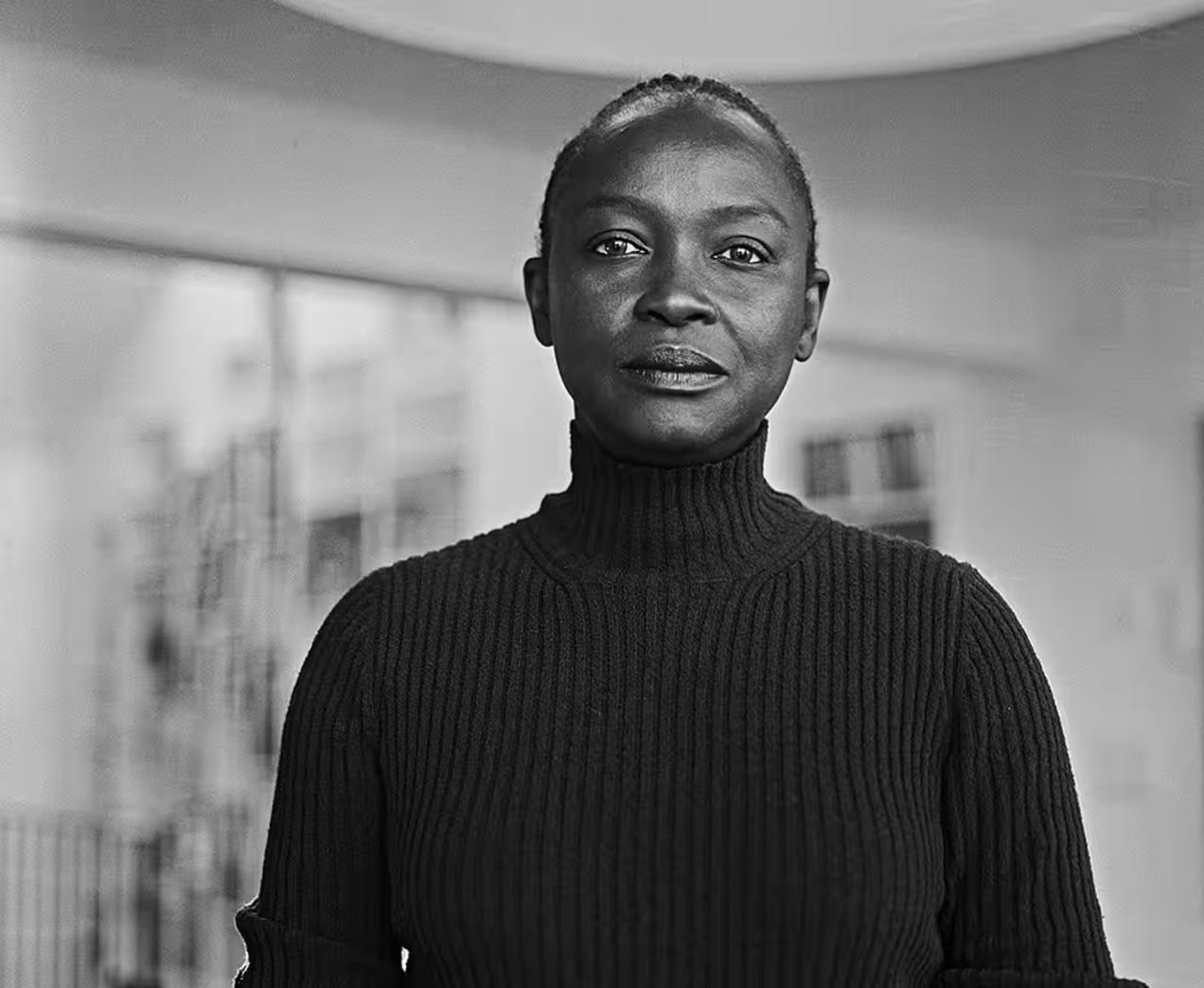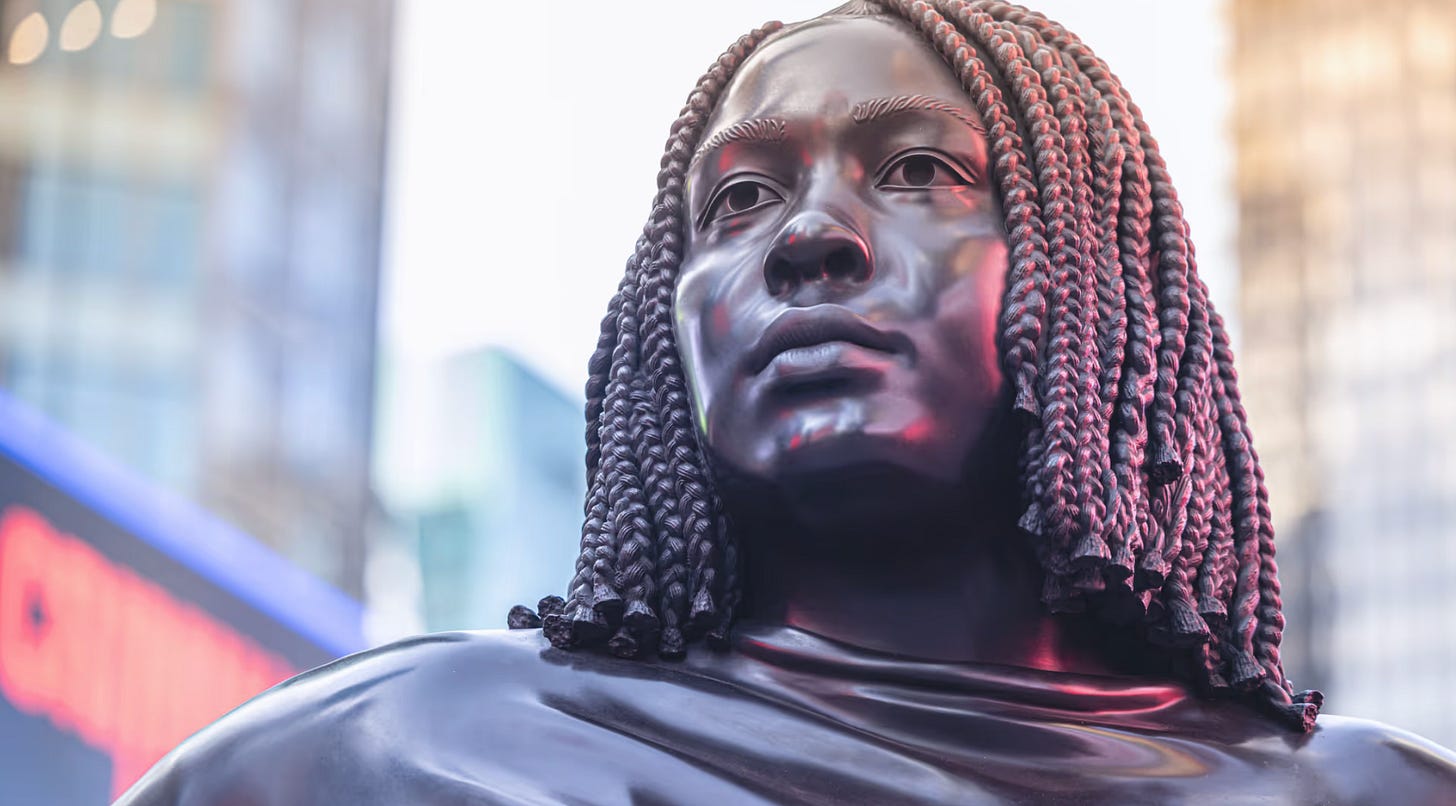Black fatigue? The pivot to identity-free Black art
When Black portraiture becomes too charged, the art world shifts to abstraction—but the power dynamics remain unchanged
The art world lost a towering figure recently with the passing of Koyo Kouoh, curator of the 2026 Venice Biennale. For those unfamiliar with her work, this remembrance shares her impact. Kouoh's legacy reminds us that curatorial vision can reshape how we understand art's relationship to power and identity.

This loss feels particularly poignant as we witness another cycle of visibility and invisibility playing out in real time. Thomas J. Price's Grounded in the Stars (2023) in Times Square has sparked conversations about Black representation in public spaces. The work is obviously important—as I discussed with Thomas in our 2021 podcast conversation it speaks to monumentality, presence and the reclaiming of public space. But the conversation surrounding it also reveals something troubling.
There's validity in the argument that as Black women we are increasingly deployed as emblems of progression, while the structures that hold us back remain unchanged. We become the face of social, cultural and political reform while doing the heavy lifting of actual change. Legacy Russell explored this phenomenon in our conversation about her book Black Meme, particularly regarding how Breonna Taylor's image was endlessly replicated after her murder. As Legacy observed, we need to "slow down and to reflect on why it is that we feel entitled to share material specific to these various moments that continue to happen to black people without asking questions about agency." Where is the agency in endless reproduction?
This connects in part to the current moment around Thomas's work in Times Square. The image of Black women—real or imagined—becomes a symbol of honouring while we remain fundamentally unhonoured in reality. We also see this in the deployment of the "strong Black woman" trope, the revered figure placed on pedestals both literal and metaphorical. But unless that reverence is replicated in reality—in wages, in safety, in institutional power, in genuine respect— is there only so far this symbolic honouring takes us before it renders itself meaningless? Have we become decorative solutions to structural problems?

As Damien Davis noted in Hyperallergic: "Black portraiture is on a timer. Every few years, institutions rush to fill their collections with Black faces, signalling progress. But the moment the optics shift, that visibility fades like a marketing campaign. This cycle of exposure and abandonment, masquerading as progress, is nothing new — it's just more visible now."
The surge in institutional interest in Black portraiture we witnessed in recent years has already begun its decline, after a relatively short run. Rachel Corbett's piece "How the Black Portraiture Boom Went Bust" in Vulture documents this market “correction.” The market has pivoted to Black abstraction, where identity narratives are less obvious and therefore more transferable—easier to sell without the obvious weight of identity politics. This shift feeds directly into what some industry folk are calling "Black fatigue," as if our humanity were a trend that had simply run its course.
In hindsight, I see how my own work was caught up in this wave. I was being invited by galleries who, it's now clear, would not have hired me were it not optically significant for them in the post-BLM moment. The cynicism became impossible to ignore. At one gallery party, a director, swinging a Negroni in hand, talked with me about the meetings they had just attended with a new Black artist on their books: "And now they are trying to crack America, so we have to go there next week" - complete with theatrical eye roll.
What's wrong with this statement? Everything. It reduces a Black artist's legitimate career ambitions to opportunism, spoken with casual dismissal by someone holding institutional power, to someone—me—who doesn't. The subtext of cat playing with mouse is clear. The respect I had for these power players left the building in that moment. What made this person comfortable to speak so candidly, about Black artistic ambition with such indiscretion and derision, to a Black person whose focus is to elevate the work of our community? As I watch that wonderful artist's career develop, I question at what cost our artists are being propelled into the limelight when those backing them harbour such attitudes.
And Thomas's Times Square installation exists in this moment, within this landscape. The work itself deserves serious consideration on its own terms, but within larger patterns of commodified representation.
This conversation requires complexity. We can celebrate the significance of these moment’s of visibility while simultaneously interrogating the mechanisms that make such visibility possible—and temporary. Koyo Kouoh understood this. Her practice asked not just who gets to be visible, but on whose terms, for how long, and to what end.
Please consider supporting Shade Art Review with a subscription. As a reader-supported publication, I share 50% of all subscription income directly with my contributors.
If you're unable to subscribe for the 83p weekly, please like and share this work to help it reach a wider audience. Shade Art Review takes hours of dedication to produce, and while we deeply appreciate your emails of support, financial contributions make it possible for us to continue publishing. Your subscription makes a real difference in sustaining independent art writing and fairly compensating contributors.





This article hit deep. Thank you for writing this very important topic. Also I’ve witnessed cases like what that director said. A lot of the power players in the art world don’t care about these black artists, they mostly view them as trending cash cows (for lack of a better word), to grudgingly promote and support their work.
This is from Scroll XVI of my project The Hidden Clinic. I wrote it as a prayer—not a statement. Not for applause. Just rhythm for witness. https://thehiddenclinic.substack.com/p/to-the-ones-who-were-set-on-fire